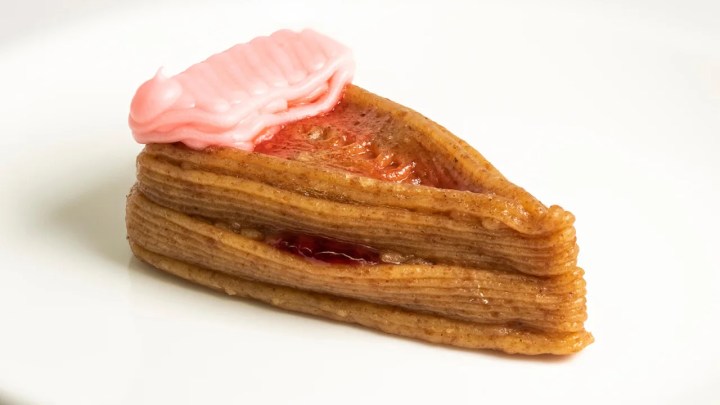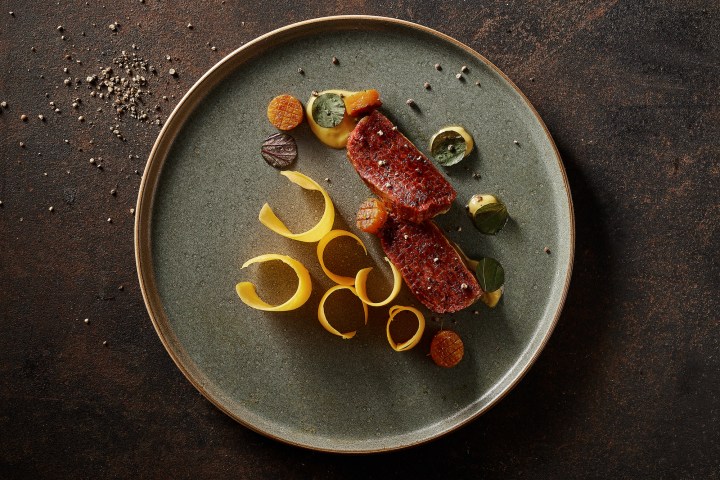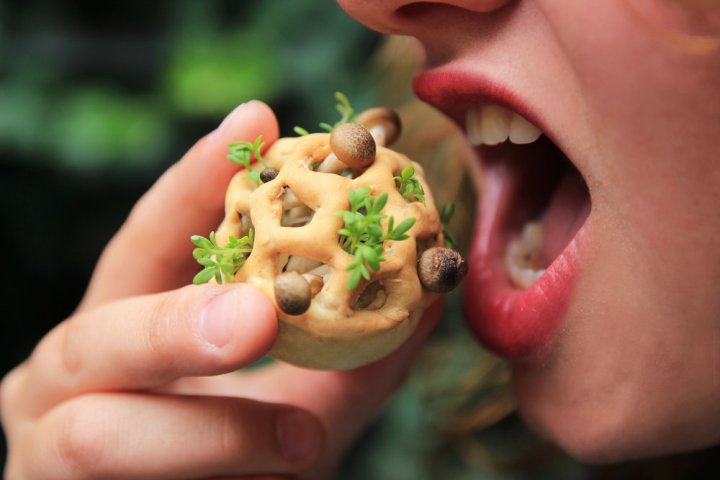Along with jetpacks, holograms, and universal healthcare, one of the great unfilled promises of the Star Trek-style future is the food replicator. Few concepts hold more sway over both the keen foodies always on the lookout for the latest trend in dining and those of us who can barely be bothered to put a frozen pizza in the oven than a box in your home which can create any meal you desire.
You press a button, and the machine whirs and beeps and creates the delicious dish of your choosing, no tedious chopping or marinating or pan-searing required. It’s an idea far too good to be true — but we might be one step closer to this paradisiacal utopia than you think.
How to 3D print a cheesecake
Researchers from Columbia University recently managed to 3D-print a cheesecake, in a process that is exactly as delightful as it sounds. They detailed their discoveries in an article in npj Science of Food, and we spoke to lead author Jonathan Blutinger to learn how they did it.
The printing hardware is very much still in the research phase and not ready for consumers, but it has successfully printed a fully edible cheesecake. The tests done by the researchers involved layering graham cracker, peanut butter, Nutella, banana puree, strawberry jam, cherry drizzle, and frosting, into one (presumably extremely sweet) dessert.

The principle of the machine is similar to a home-use 3D printer, but replaces spools of plastic filament with what the researchers call “food inks”. Foods are processed to a puree consistency and loaded into off-the-shelf food-grade containers, which are extruded by the machine to lay down layers of each flavor as required.
Each print is a delicate, laborious process on the current machine, and it takes time to set up and tweak each individual element of the print. The group is working on a way to simulate prints before they run them, to save on time and materials. But to get to this point required sitting through a lot of failed prints — which were apparently a chore for the researchers, even if they are rather delightful for an audience.
“It really hurt me inside when that was happening,” Blutinger said with a sigh. “That was hard to watch.”
There are a few essential rules of food printing that have emerged from this mix of successful and failed prints. You need to use firmer ingredients to build up structural elements like walls which can be filled with softer ingredients, taper the walls of these structures so they are thicker and the bottom and thinner at the top; remember to leave space for the printing nozzle when using ingredients as filling.
Many of the principles of printing using food are similar to the principles of construction we see in other settings, like building homes. It turns out that engineering axioms still apply, whether you’re constructing in brick or in banana.
Making printed food more palatable
As neat as this technology is, something researchers working in this area are keenly aware of is the ick factor which people can experience about what they’re eating. In a world where many people are focusing on trying to eat more whole foods and consume fewer additives, the technologization of food into printable pastes could be off-putting.
One way Blutinger’s group approaches this challenge is to keep the ingredients they use in their projects close to those that you’d find in any kitchen. The bananas used in their cheesecakes, for example, were bought from the grocery store (the paper specifies it was Appletree Market in New York City, presumably in case a replication should be required) and mashed by hand by the researchers themselves.
(“We handmashed a banana with a fork until the consistency was uniform to ensure that the nozzle tip would not be obstructed during extrusion,” the article states, in a strong contender for my all-time favorite sentence published in an academic paper.)

That was a deliberate choice to keep the ingredients used in the cheesecake close to the familiar. “It irks people enough to have food that they eat considered as ‘printed’,” Blutinger said. “So we had this mental shift that we had to work with ingredients that people were familiar with. It needed to be things from the grocery store, things we’re used to interacting with on a daily basis.”
The group works with a nutritionist and they stay away from what he described as “goops and powders” to try and make people comfortable with the idea of this new way of preparing dishes. “We’re using all the same stuff you usually cook with, it’s just the way it’s being assembled is different,” he said.
There are still practical concerns with working with fresh food ingredients, like needing to store certain items at particular temperatures. The current system is to load food into the food-grade tubes then keep those tubes in the fridge as required, and to thoroughly clean the machine after each use. That sort of thing could be automated in the future to ensure food safety, meaning that printed food would be just as safe and healthy — or even more so — than food prepared by hand.
It’s still a mental shift to think about food preparation in this way, but it needn’t be a negative one in terms of palatability. “If anything I think in a weird way it brings you closer to the food,” Blutinger said. “Because you can see all the ingredients that go into it, and you can see it being made in front of you.”
Going beyond cheesecake
3D-printed food is a growing area of interest, and it’s already popping up in areas you might not have thought of. One area in which 3D printing is already being used is in plant-based meat alternatives, where a variety of companies are using the technology to produce foods that have the texture and flavor of the meat but without causing harm to animals.
“If you think about 3D printing as controlling a bead of food on a millimeter scale, each one of those beads could be muscle fiber or fat fiber in a printed steak,” Blutinger explained. “So you can create your own unique marbling patterns.” (He also does research into this area for the Israeli company Redefine Meat.)

There are 3D-printed plant-based steaks being produced and eaten now, primarily in Europe, but the future could see a much broader range of food printing possibilities. One thing that 3D printing can do that human cooks generally can’t — bar a few highly skilled professional chefs — is to prepare ingredients in extremely thin layers, changing the way the flavors meld or complement each other.
“Take a typical dinner: Last night I had salmon, mushrooms, asparagus, and rice,” Blutinger said. “If I could layer that in a new way and interlace those ingredients to create a flavor I haven’t had before — that’s a pretty cool thought.”
For more complex food creations, we’ll need a way not only to assemble food but also to cook it. Blutinger’s group is also working on this with a new method called laser cooking, which uses lasers that can penetrate into food to cook it either on the inside or the outside as required. It’s possible that a future appliance could combine 3D printing and laser cooking for a one-box solution for preparing all kinds of meals and snacks.
The future: new types of food
Most of the work on 3D printing food so far has focused on trying to recreate familiar dishes using this new technology. It’s particularly useful for customizing individual orders, like a machine that could easily make a batch of burgers for a family, one of which has no onions and another of which has extra ketchup. But its adherents say its potential is far more expansive than that.
The vision is for a 3D printer to become a basic appliance in any kitchen, used for everything from assembling healthy and personalized at-home meals to producing wild creations for high-end restaurants.

And that means the types of food we make with a printer could be largely new. “Most of the foods we’re used to eating have been optimized for our cooking appliances and utensils,” Blutinger said. Take the beloved pizza, which is perfectly suited to being assembled by hand and baked in a hot oven — a 3D-printed version is unlikely to improve on this long-refined classic.
But 3D-printed food could become something totally different. Because of the way it can lay down thin layers, it can create entirely new eating sensations — like the cheesecake, which apparently was interesting to eat because each of its seven ingredients could be tasted in a wave. “It changes the way you have to think about food being assembled,” Blutinger said.
For now, though, we’re just starting to explore this new world of food possibilities, and that begins with these unconventionally flavored printed desserts. So perhaps the most important question is a simple one: Did the researchers eat the cheesecake they printed, and was it tasty?
“Yeah!” Blutinger said. “It tasted good.”



